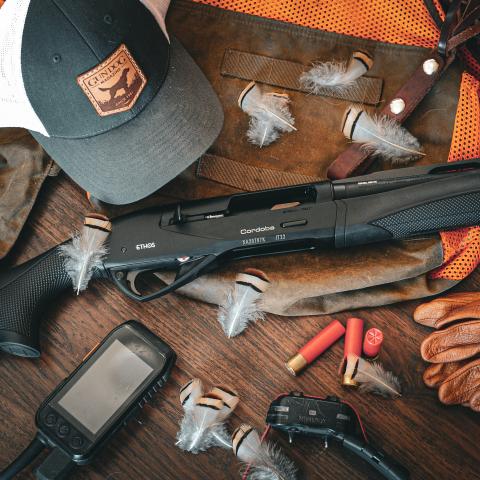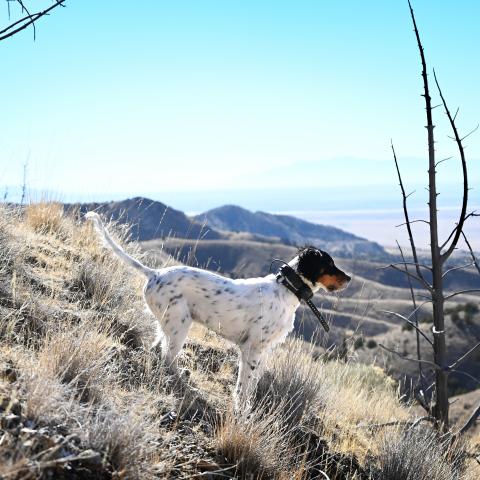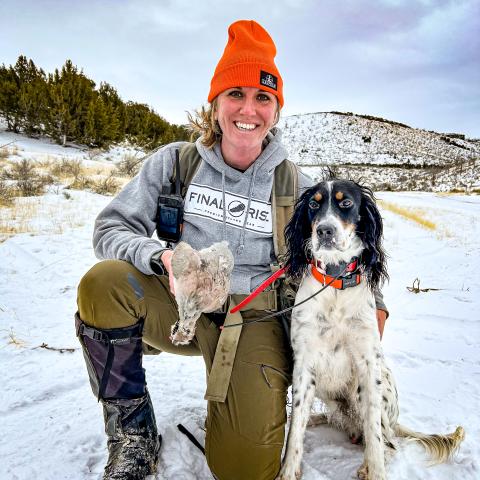The Journey- A new puppy, lingering doubt, and real honesty on building a bird dog.
My boot slipped on the icy lava rock, sending my shooting hand deep into the snow to catch myself from falling down the steep mountainside. Placing the buttstock of my Ethos on the rock above me, I pushed my body upward as I rushed to climb over the sharp, slick red rock.
My lungs and legs burned, but I was in a hurry as my GPS beeped again to indicate my young English setter, Jones, was on point 50 yards above me. The canyon was so steep that I couldn’t see my dog, but he had been standing still for a few minutes meaning he had found me birds.
Cresting the last rise, Jones was there, stiff as a board, tail pointing to the heavens and unwavering. He was sure birds were in front of him.
The covey flushed just as I reached my young dog, one chukar swinging down the mountain. I pulled the trigger of the Ethos, sending a load of 28 gauge in its flight path and stopping the red-legged devil in midair.
Jones, my first pointing dog, the puppy whose training had left me sleepless at night, had connected the dots and pointed me a wild covey of chukar in the Idaho backcountry.
The Puppy Protege
You're hard pressed to find an upland hunter that doesn't have a brace of bird dogs. If not two, then at least three—or five. They say once you have one bird dog, you get the itch, and you want just a few more in your arsenal.
I did not.
I had one beloved bird dog. He had been by my side for six years and was, of course, the best bird dog I could ever ask for. We were the dynamic duo. A third would throw off that equilibrium, that perfect balance. But Lincoln was getting up there in age. “He can't hunt for three days in a row forever,” my friends told me. Deep down I knew they spoke the truth. It wasn't fair to ask that of him. If I wanted Lincoln to hunt for years to come, I needed another bird dog. That’s where Jones enters this story.
Adding another Labrador would be the safe bet for me. I had many years with the breed, and I knew their temperament and felt confident in their required training. But Lincoln was my flusher/retriever. I didn’t need another of him.
I considered multiple pointing breeds including wirehaired pointing griffons and Gordon setters, but I didn’t know the breeds well enough. No, the obvious choice for me was an English setter.
Setters had been the choice of my Grandpa Malina. He was one of those inflicted with the disease of bird dog-itus. He didn’t have just one setter. He had 10, maybe more. His retirement was spent transforming his farm that had once housed hundreds of Hereford cattle to a setter training sanctuary.
I spent my summers through high school earning extra cash by riding his field trialing horses to keep them in shape. That gave me ample time to see his setters at work, and their sweet demeanor when greeting them in their runs. It was my duty to feed his pigeons that he used for training when he was out of town. Honestly, I should have known I was destined to become a pointing breed owner when I spent an hour one Saturday trapped in the pigeon coop before being rescued. But that’s a story for a different time.
He always had one dog in the house: A female liver and white setter he called Sam. She had a sweet disposition and was calm and gentle. She did, however, have a weird tendency to put her snout in your face to get a nose full of your breath—her own sort of test you had to pass before being deemed worthy of sitting next to her. This smell test I could excuse, but it was all the attributes above that had made the decision for me—and that’s how Jones came to complete the tripod of hunter, flusher, and pointer.
A First Point
It was love at first sight when I walked up to the pen full of setter puppies upon my arrival to Jerry Kolter and Betsy Danielson’s Northwoods Bird Dogs. Jones stood out from the rest right away. He was wrestling, and winning, with his litter mates, but also exploring the pen by himself. I liked his independent attitude. It was almost as if I were drawn to him. The final decision was made when Jones sat at attention and stared at Lincoln with genuine curiosity when I let him stretch his legs after the long car ride.
That little setter pup was coming home with us.
But, this is the part of the story where I mention my growing anxiety over my lack of experience of training a pointing breed. Sure, I had hunted over numerous pointing breeds during my time as an upland hunter, I’m friends with trainers across the country, I’ve read books and watched enough YouTube videos to make my vision go blurry—but that didn’t make me an expert on the subject.
What if I messed it up? What if the visions of shooting a bird over the staunch point of my setter while hunting some picturesque landscape of the West was replaced by a dog that couldn’t find his food bowl? His success, and failure, rested on me, his handler.
“This dog is bred and born for this,” Jerry explained to me. “He is meant to hunt and as long as you focus on building prey drive by hunting him and exposing him to wild birds the first year of his life, this setter will become a wonderful bird dog.”
He was right, of course. But it took me a long while to trust myself and trust the process. The influence of social media didn’t help. I saw other puppies that were doing things my setter pup hadn’t done yet. He hadn’t pointed a wing on a string at first, he used his nose to find a dead bird I had planted, but he didn’t point it. A frantic text to Jerry asking if I were doing something wrong was met with a simple reply: “Use live birds.”
Building his prey drive with live birds brought out his natural instincts, and at five months old I watched him point his first birds. His little machine of a nose was tracking a couple of planted chukar that hunkered under a sage brush bush. I watched as he weaved around the sage, smelling where the birds had run, and that’s when it happened. His body stopped on a dime in a beautiful tripod point and his tail stood stark straight. His eyes were locked under the bush, while my eyes were filling with tears.
Building a Bird Dog
From that first point, Jones’ instincts continued to grow as our summer training progressed. He would find and hold point on any planted bird you trained with. But as for wild birds, he was running through them, busting coveys left and right. I was frustrated. I was nervous. But I pressed on because wild birds make bird dogs, and with enough contacts and practice, I knew Jones would learn from his mistakes in the uplands.
And he did.
One November day in Idaho, we weren’t 200 yards from the truck when I came over a rise to see Jones standing tall. Thinking he was honoring my friends Drahthaar, I was astonished when I saw the black speck of the Draht long past Jones in the distance. I stood staring, mouth agape as a covey of Huns bust from the cheat grass in front of Jones. My little setter had connected the dots and pointed his first covey of wild birds.
It wasn’t a few moments later that he went on point again. Not used to this strange sight in the wild, I cautiously approached him. He stood tall, tail upright and unwavering—he was sure birds were in front of him. The covey flushed and one bird fell. I think all of Idaho could have heard my cheers of excitement.
Puppy No More
When I crested the rise of that steep, snow covered canyon in Idaho, my lungs were burning, but I had to get to Jones and quickly. Still young and learning, I didn’t want his efforts to be blown from me taking too long to climb to him.
A year had passed since that first wild covey connection that November day in Idaho, but seeing Jones on point still gave my stomach the same butterflies. As I reached his level, I carefully side stepped along the mountain, ready for the covey to bust at any moment.
The report of the Ethos rang across the valley when those wily birds took flight. We both rushed together to the downed chukar, his tail racing in excitement as we admired it together. He knew he had done well.
Jones pointed four different coveys of birds for me that day, and each time my heart beat in excitement like the first time I watched him connect the dots. My dreams of seeing my setter on point in some picturesque Western landscape had come true.





